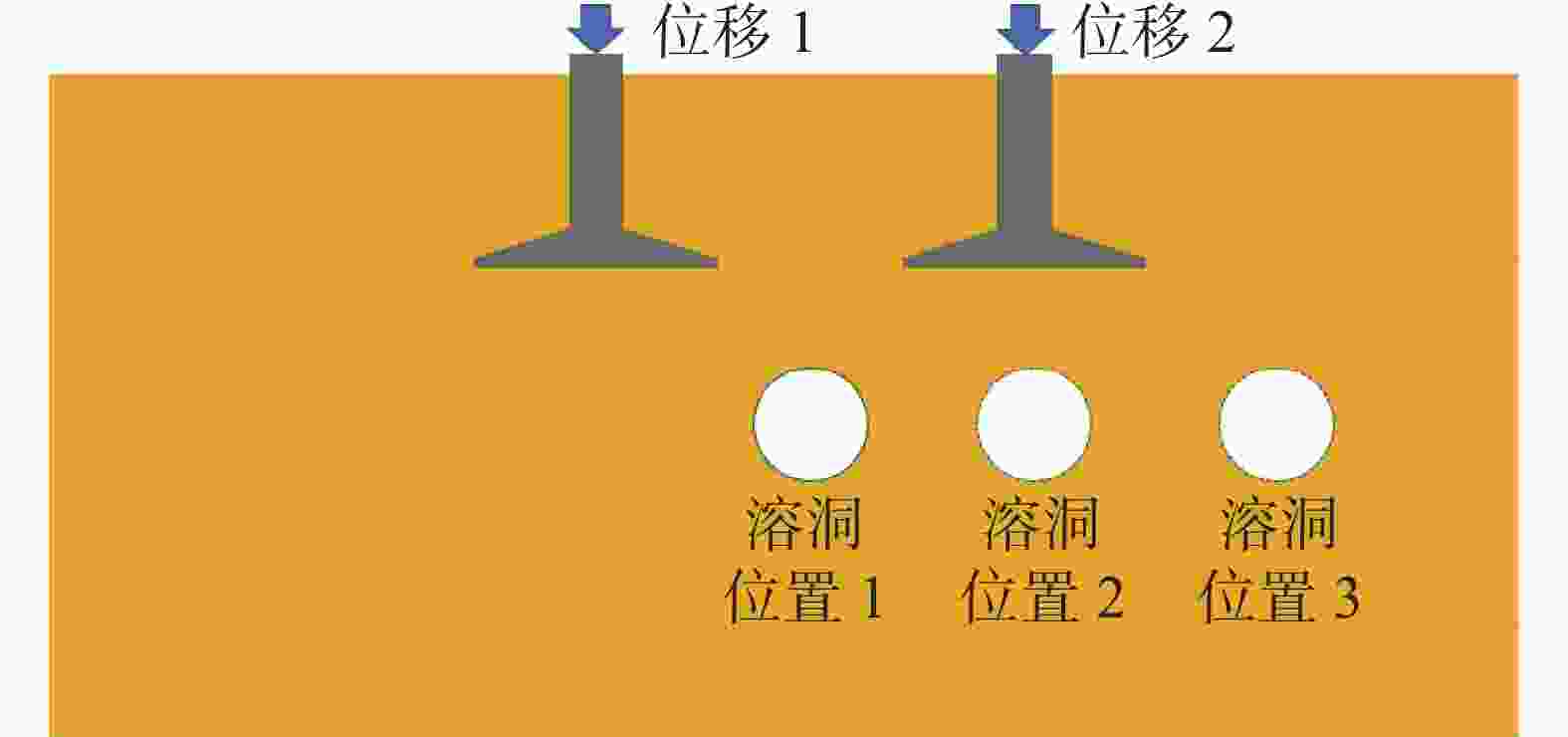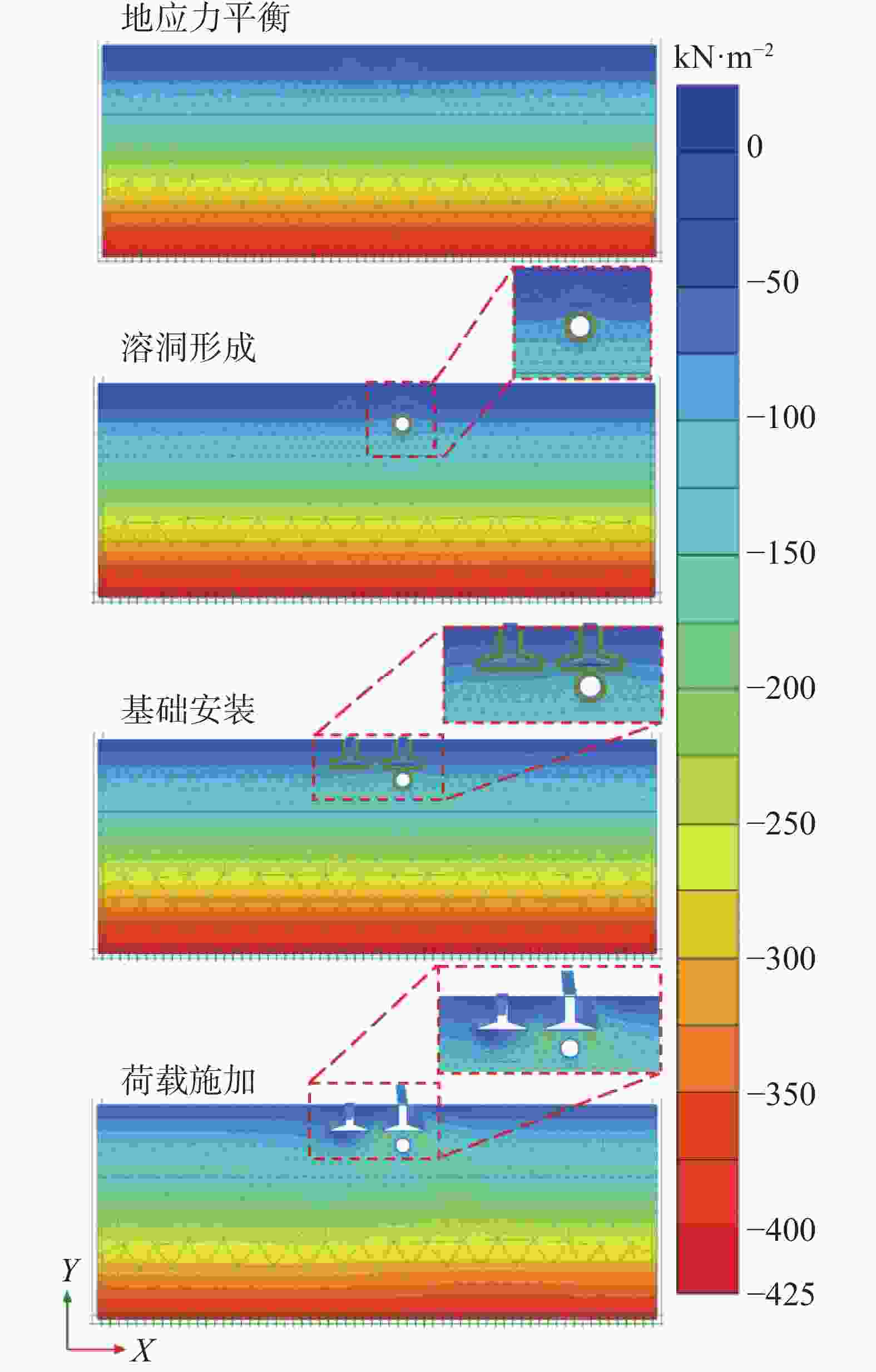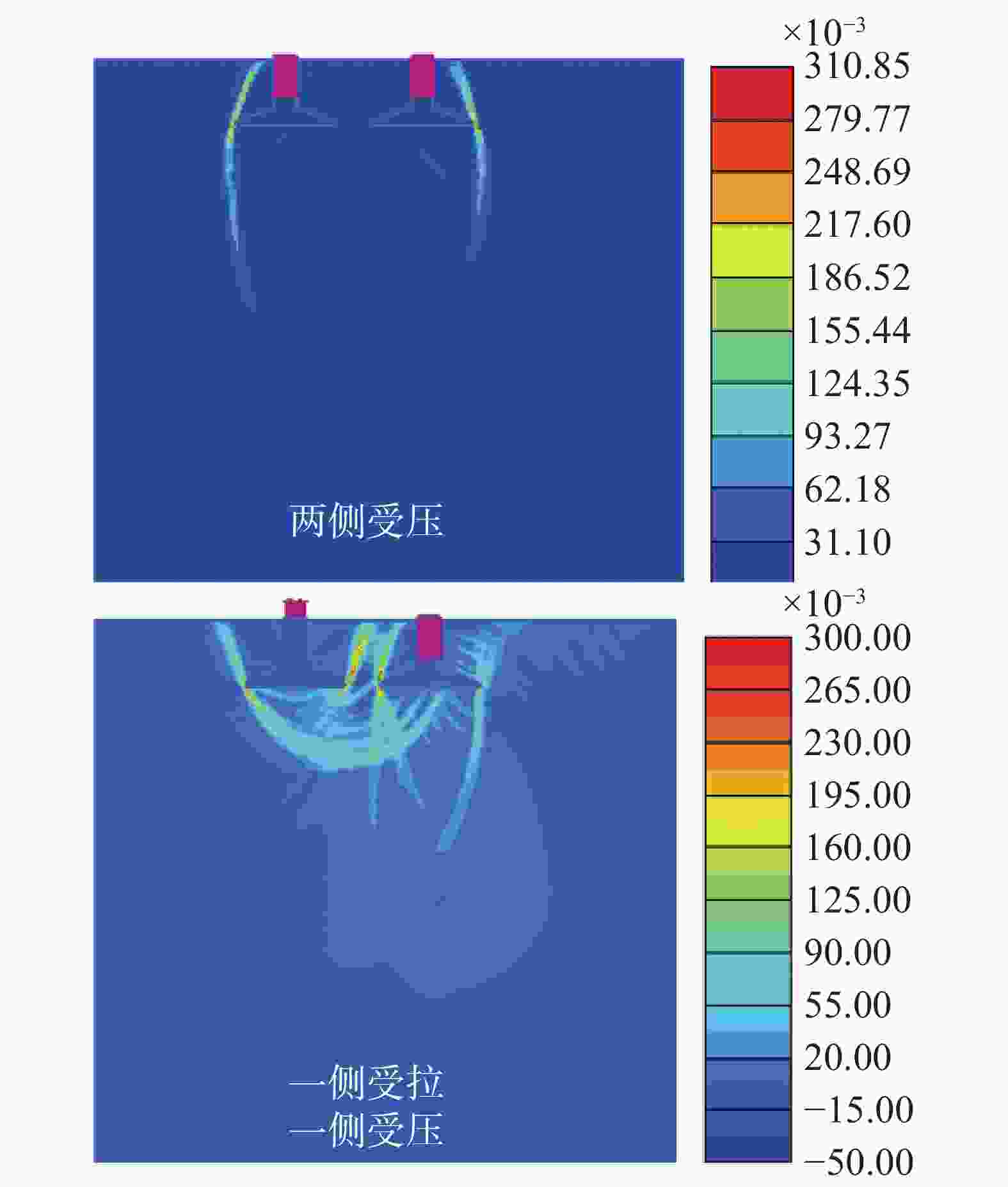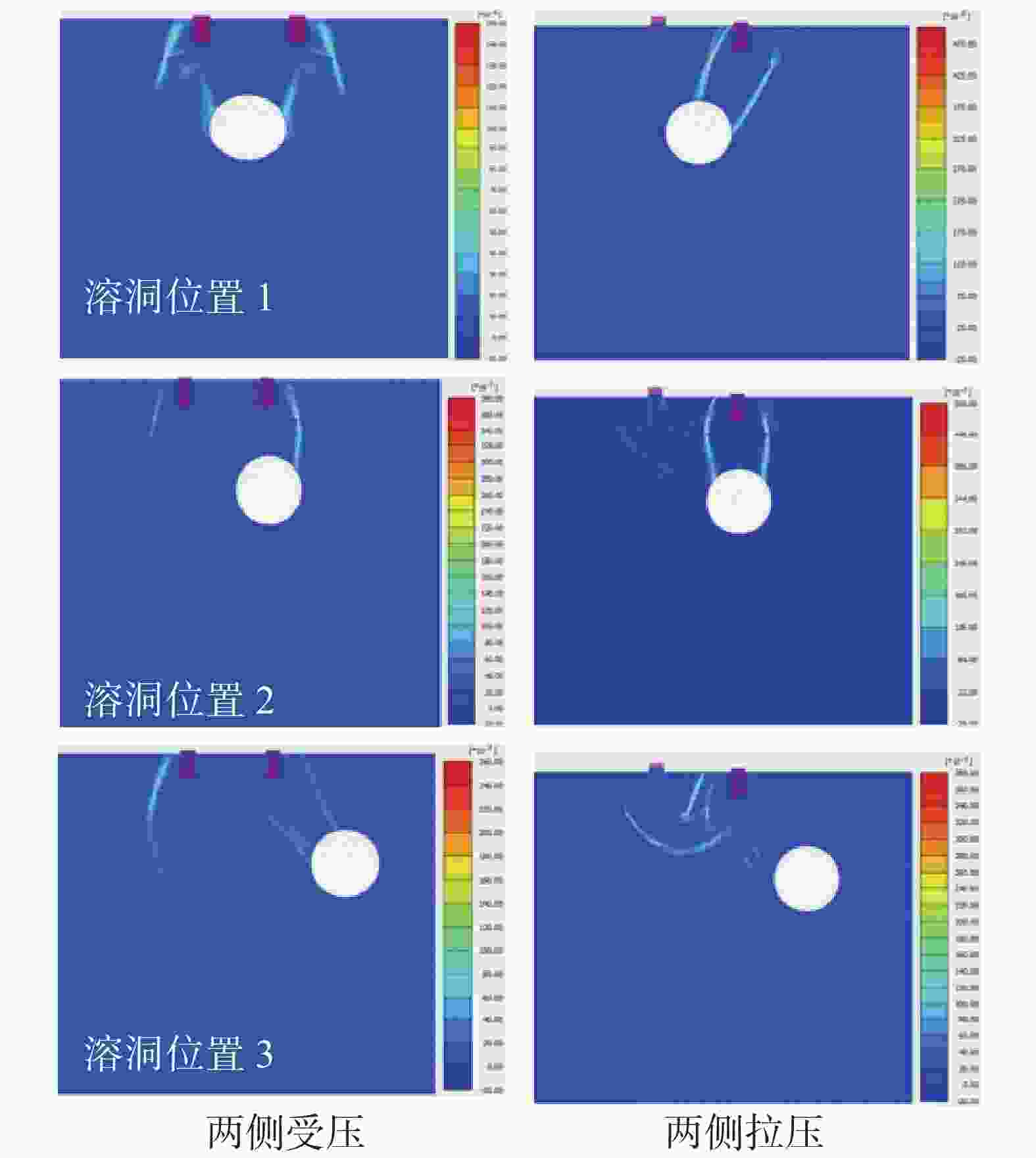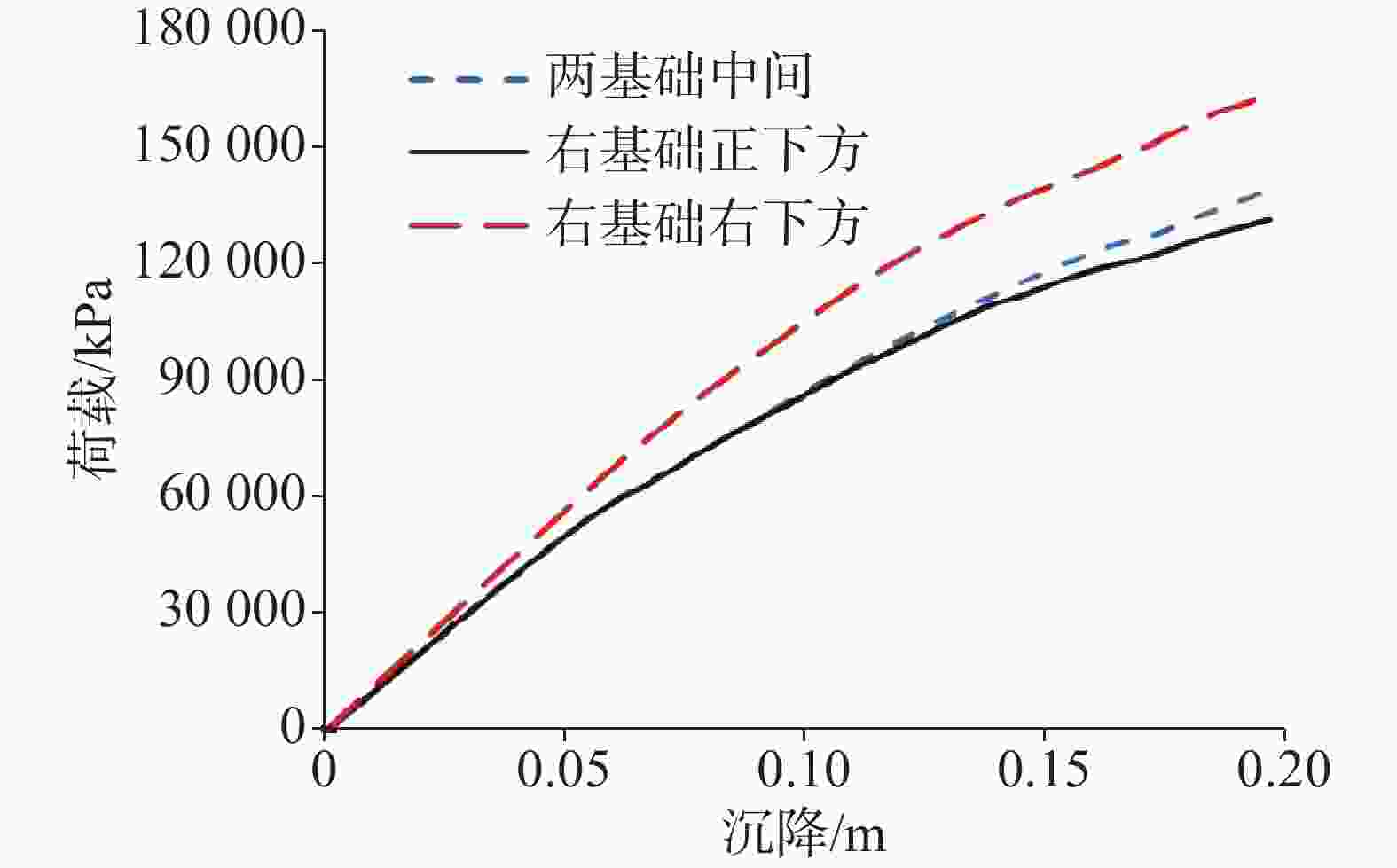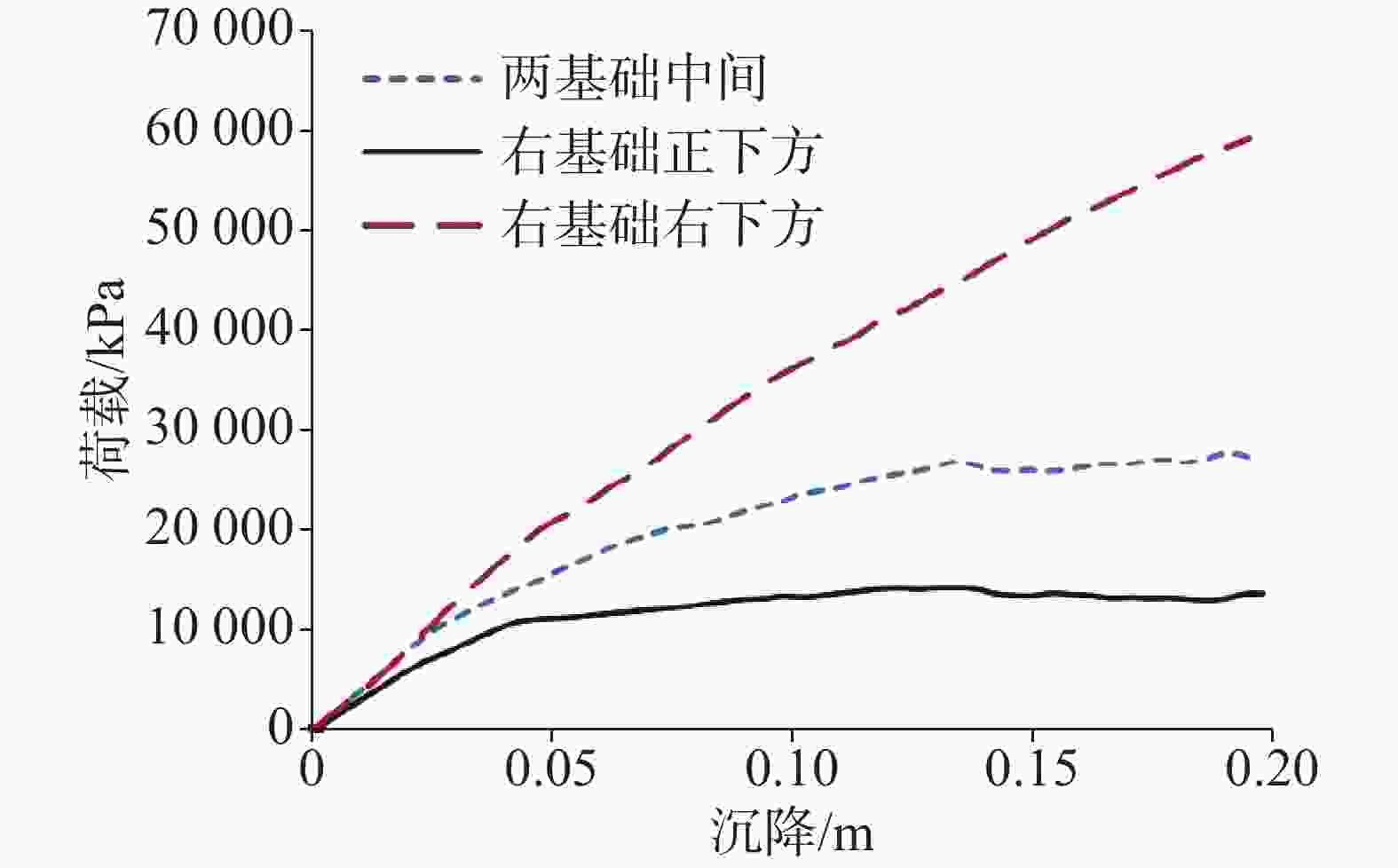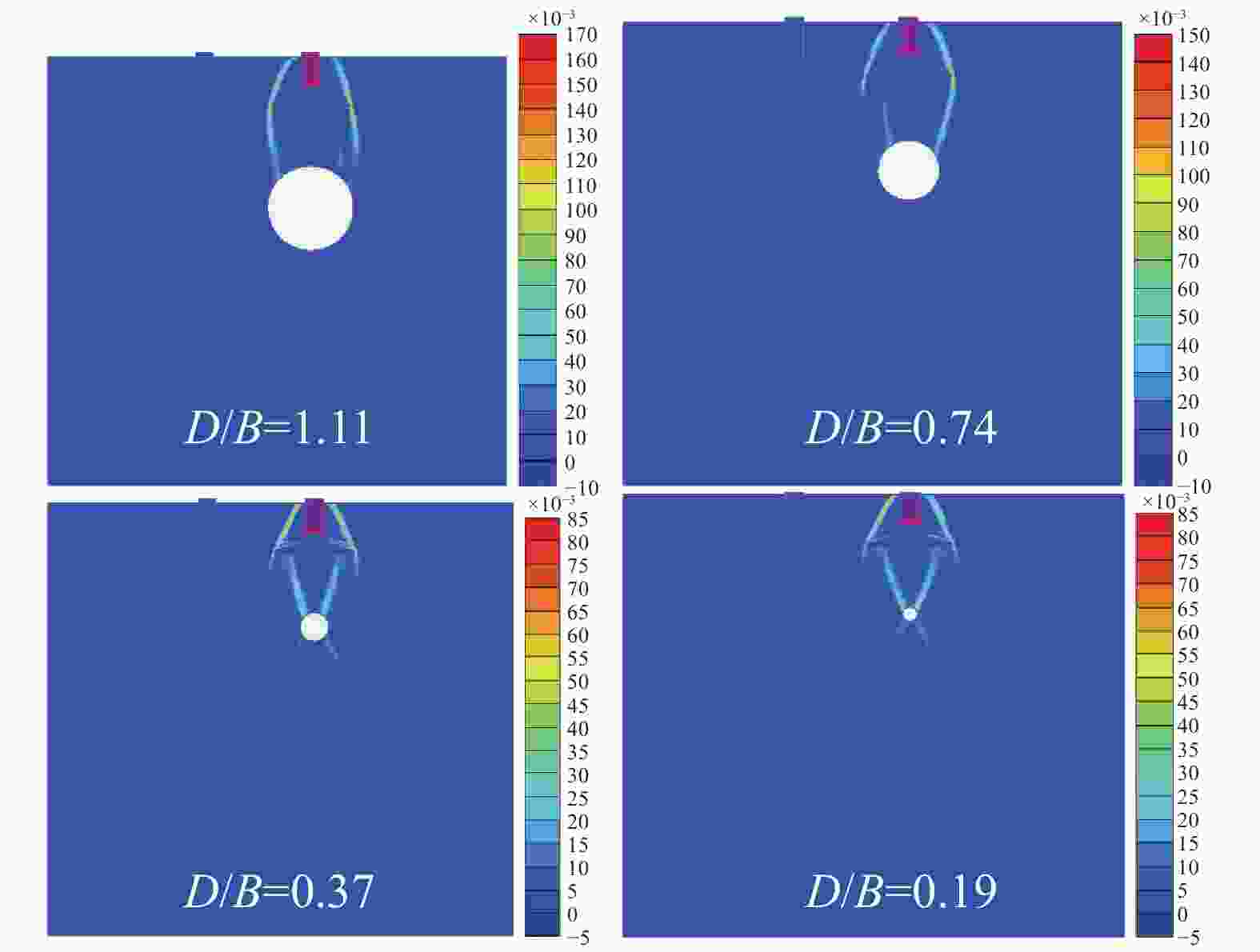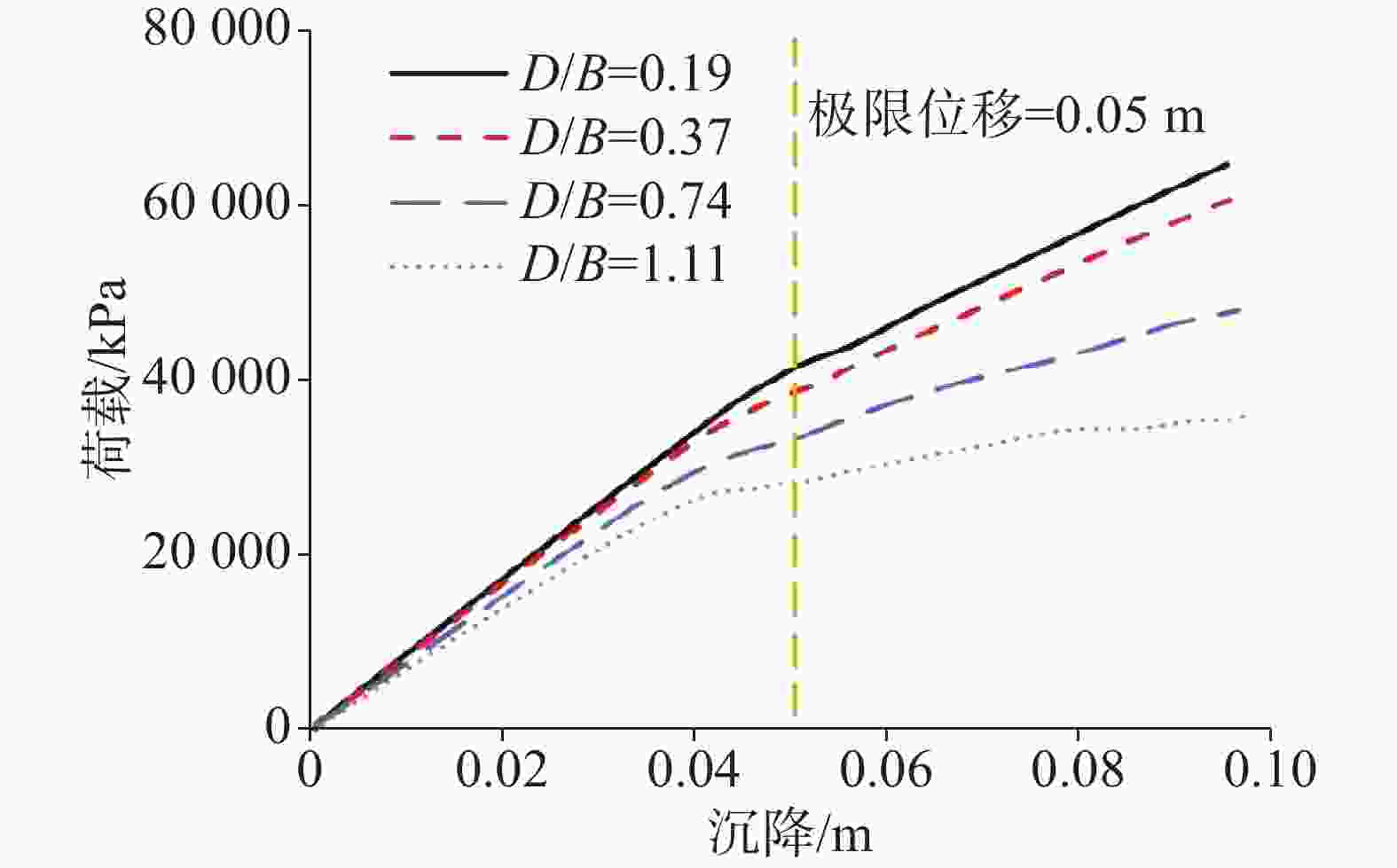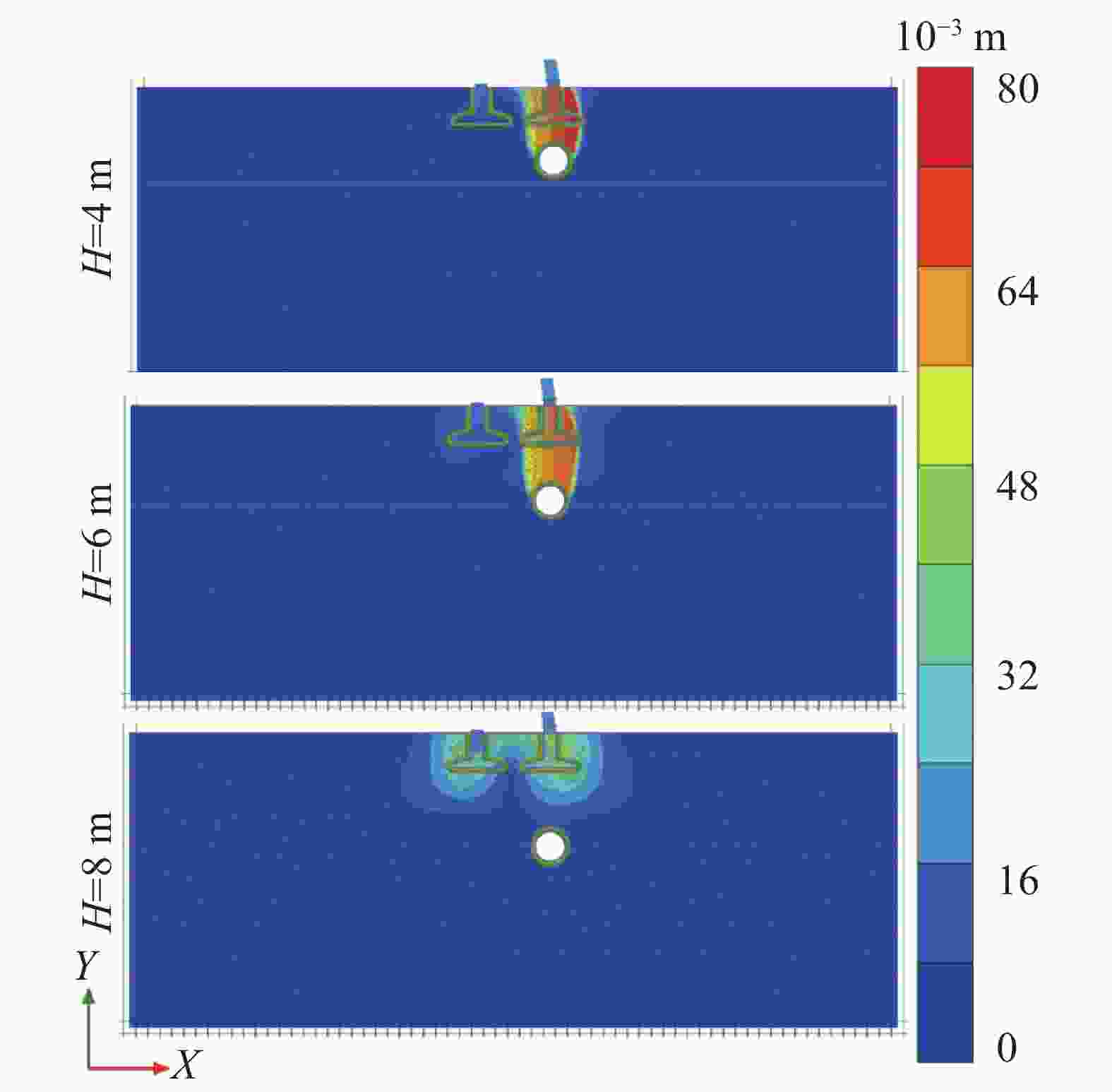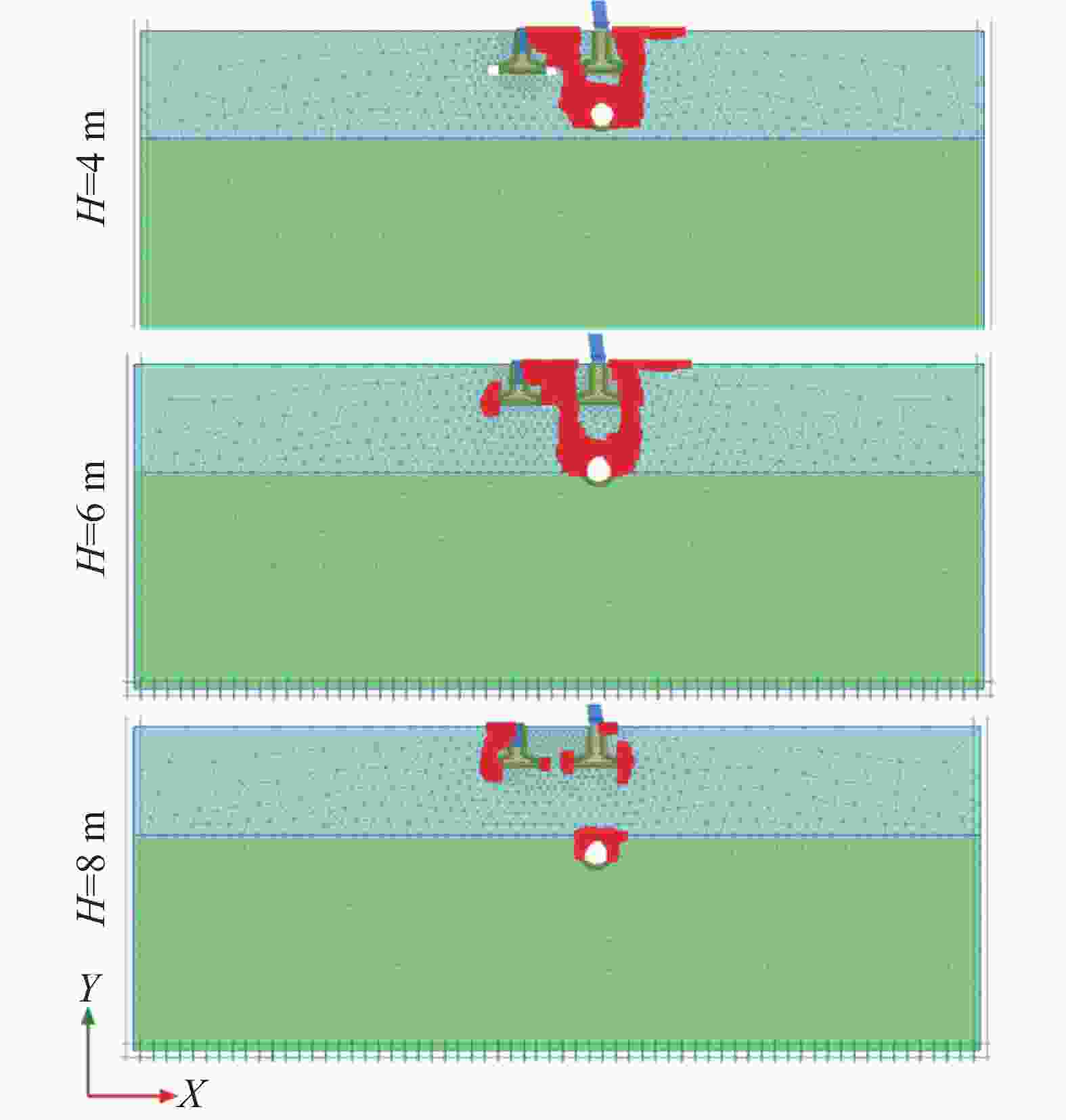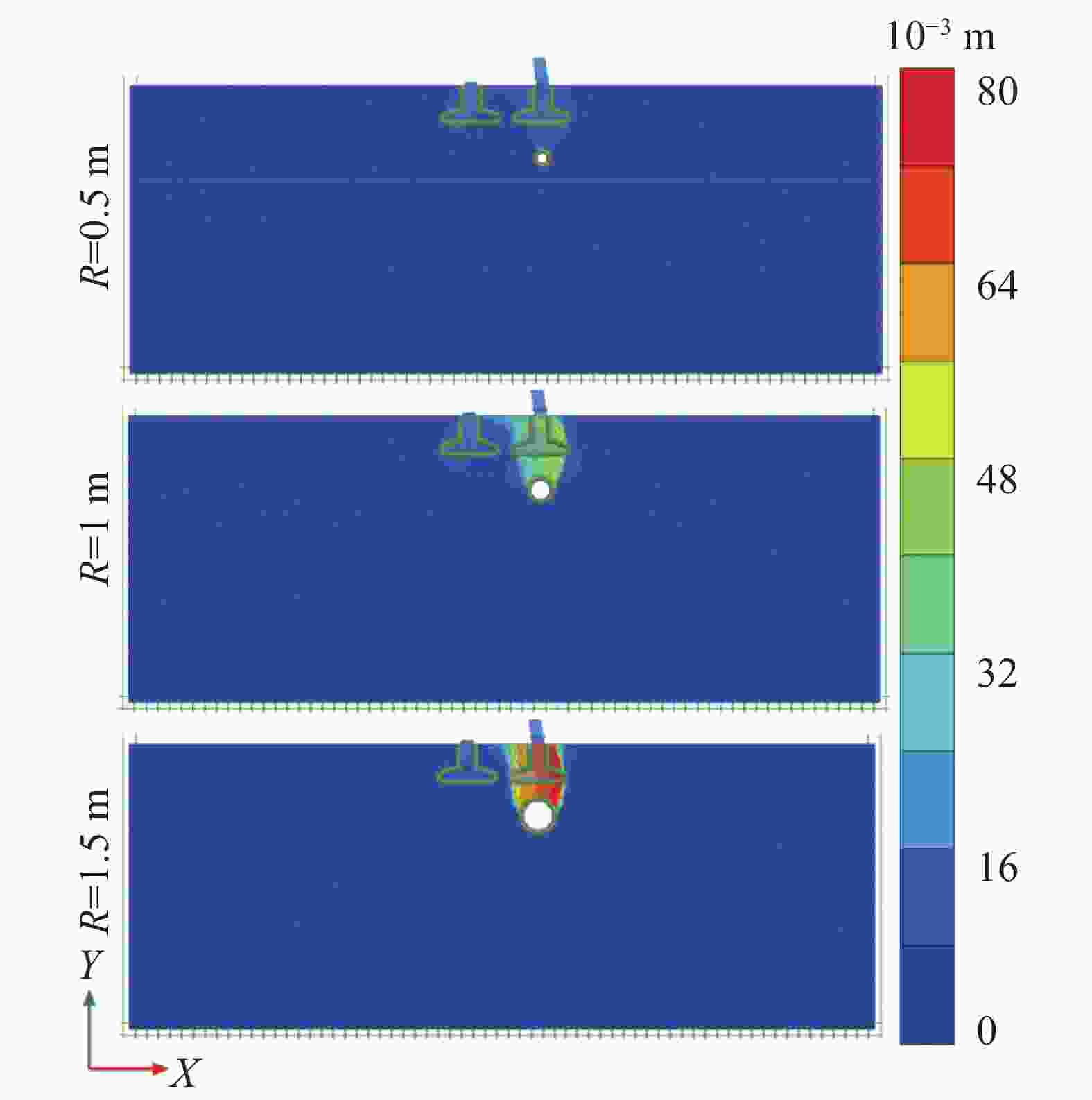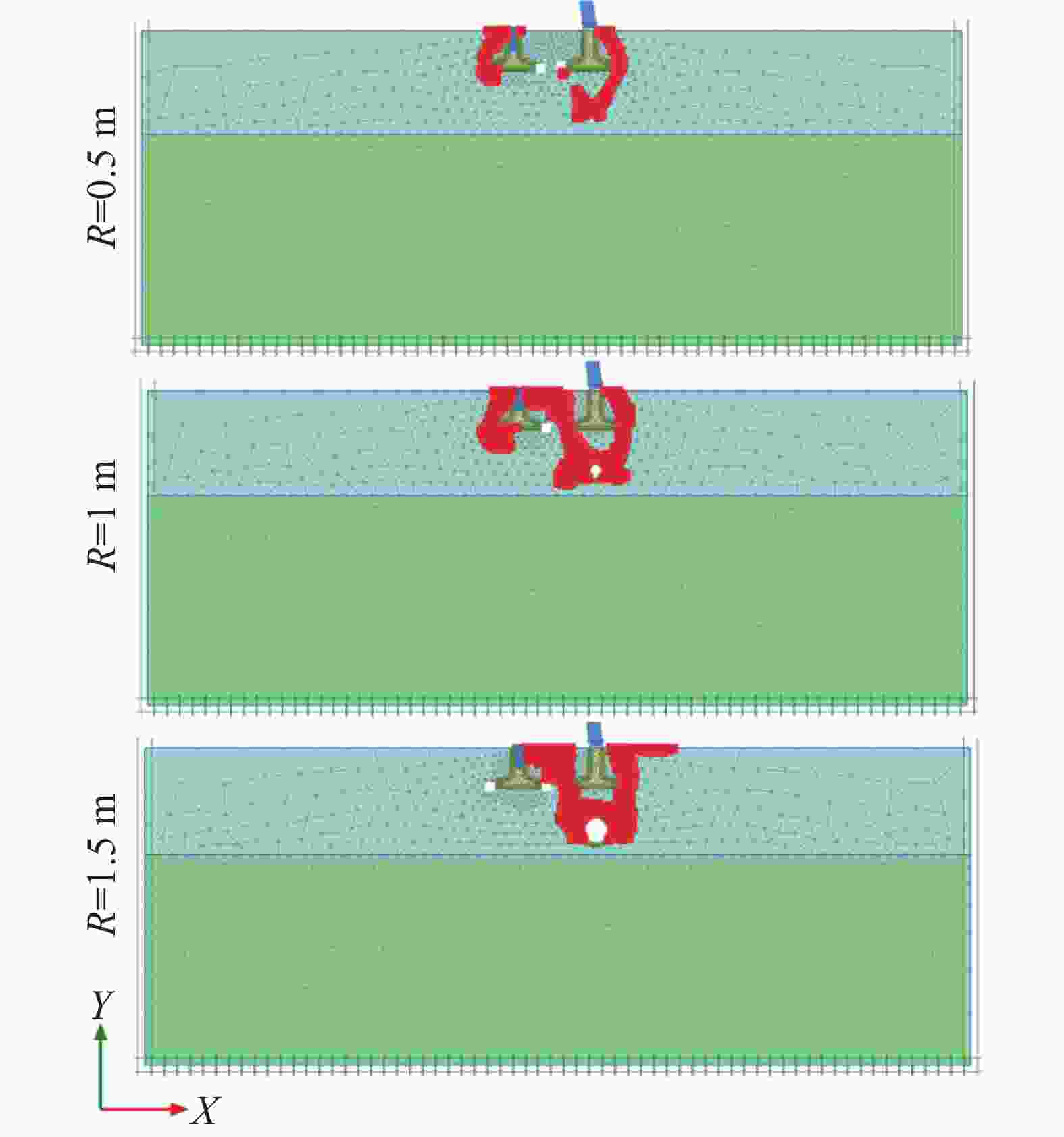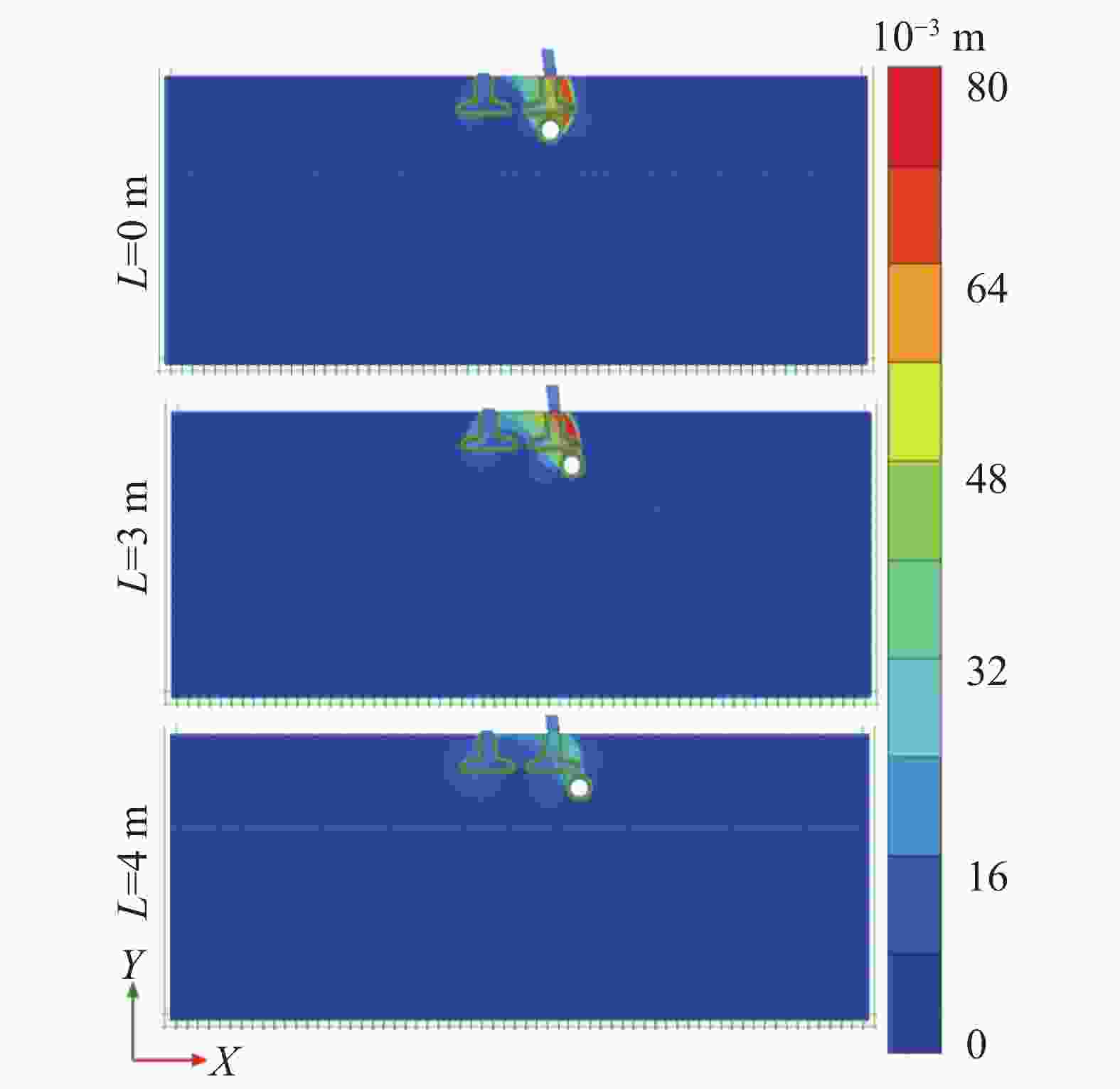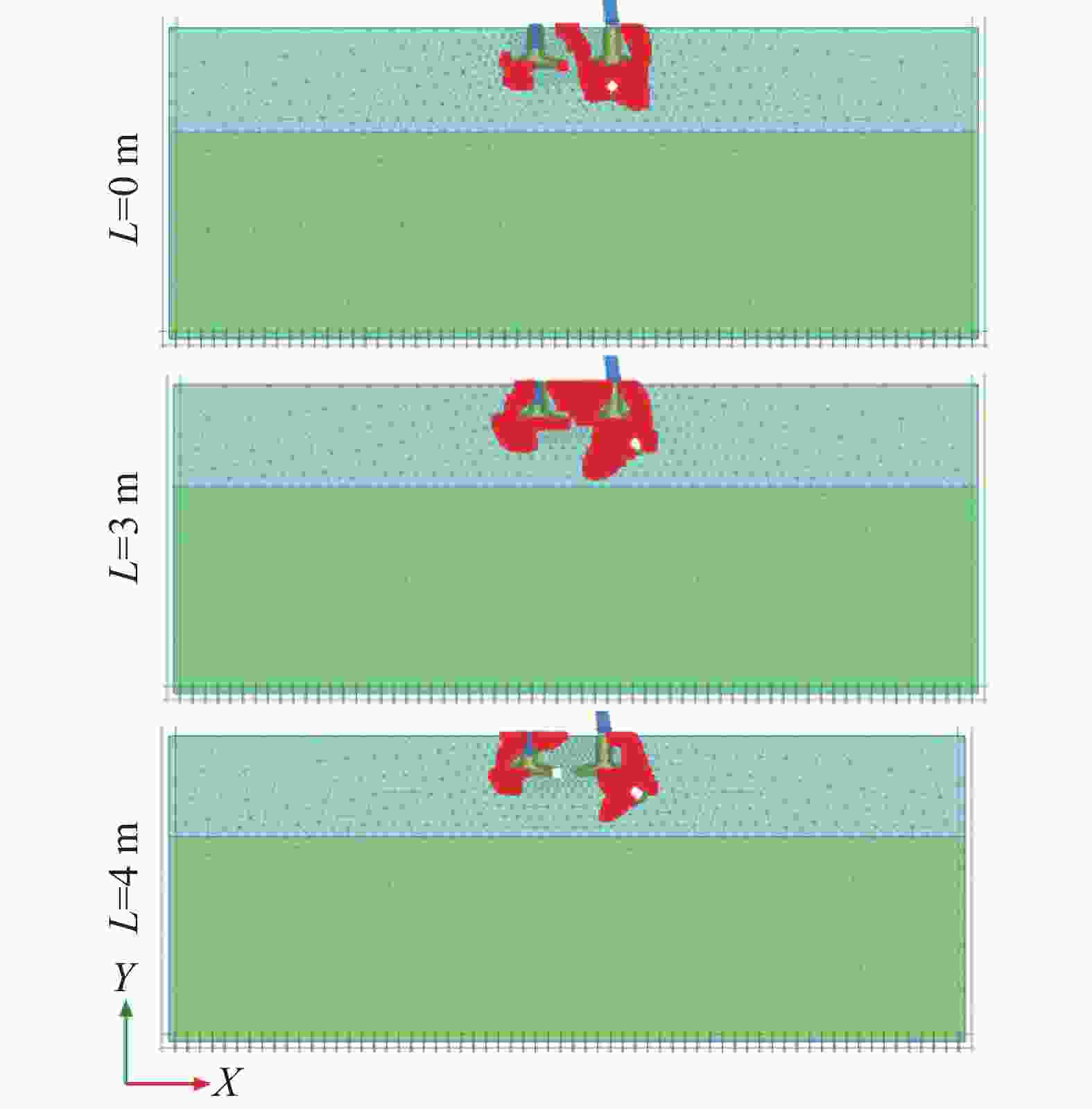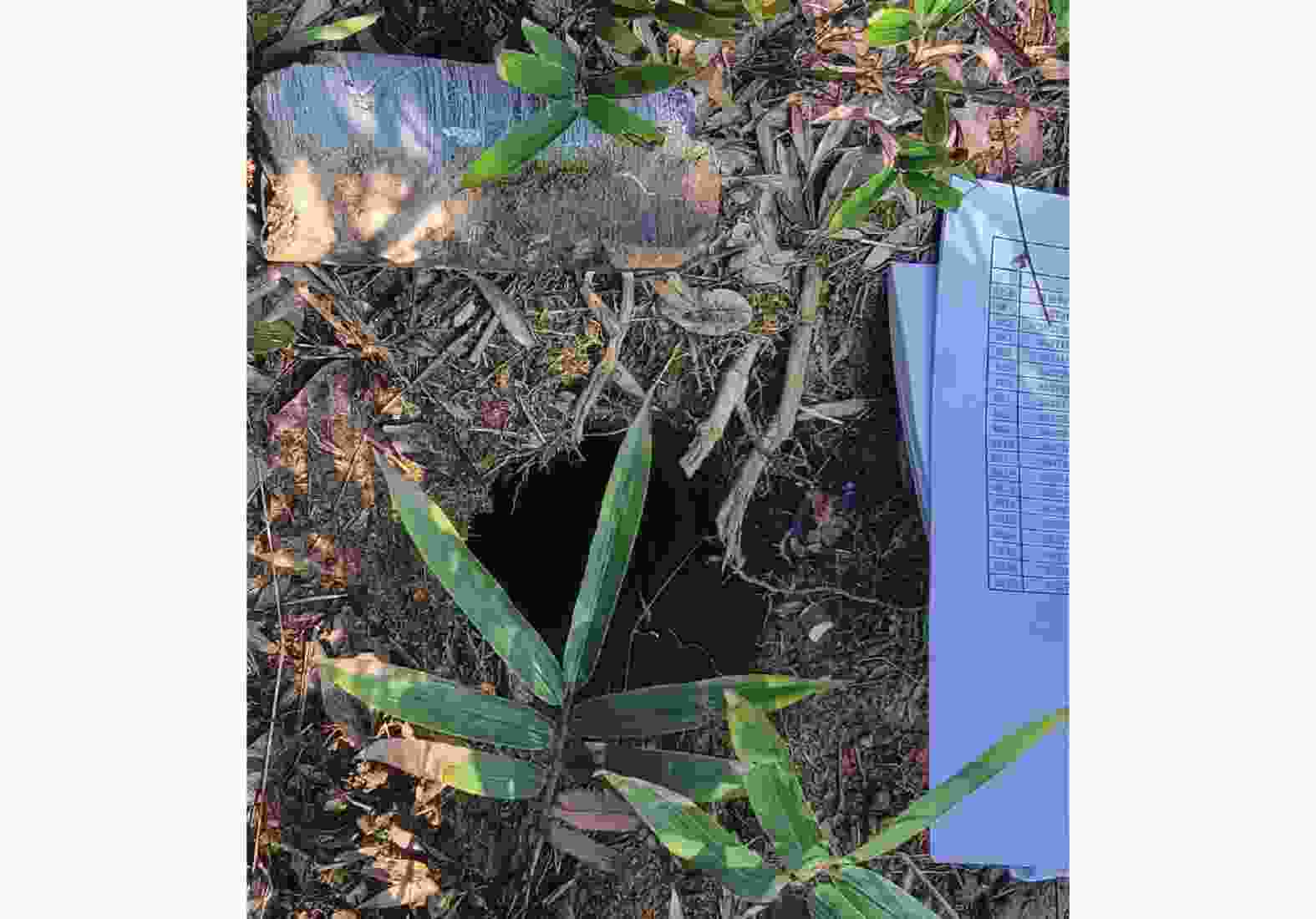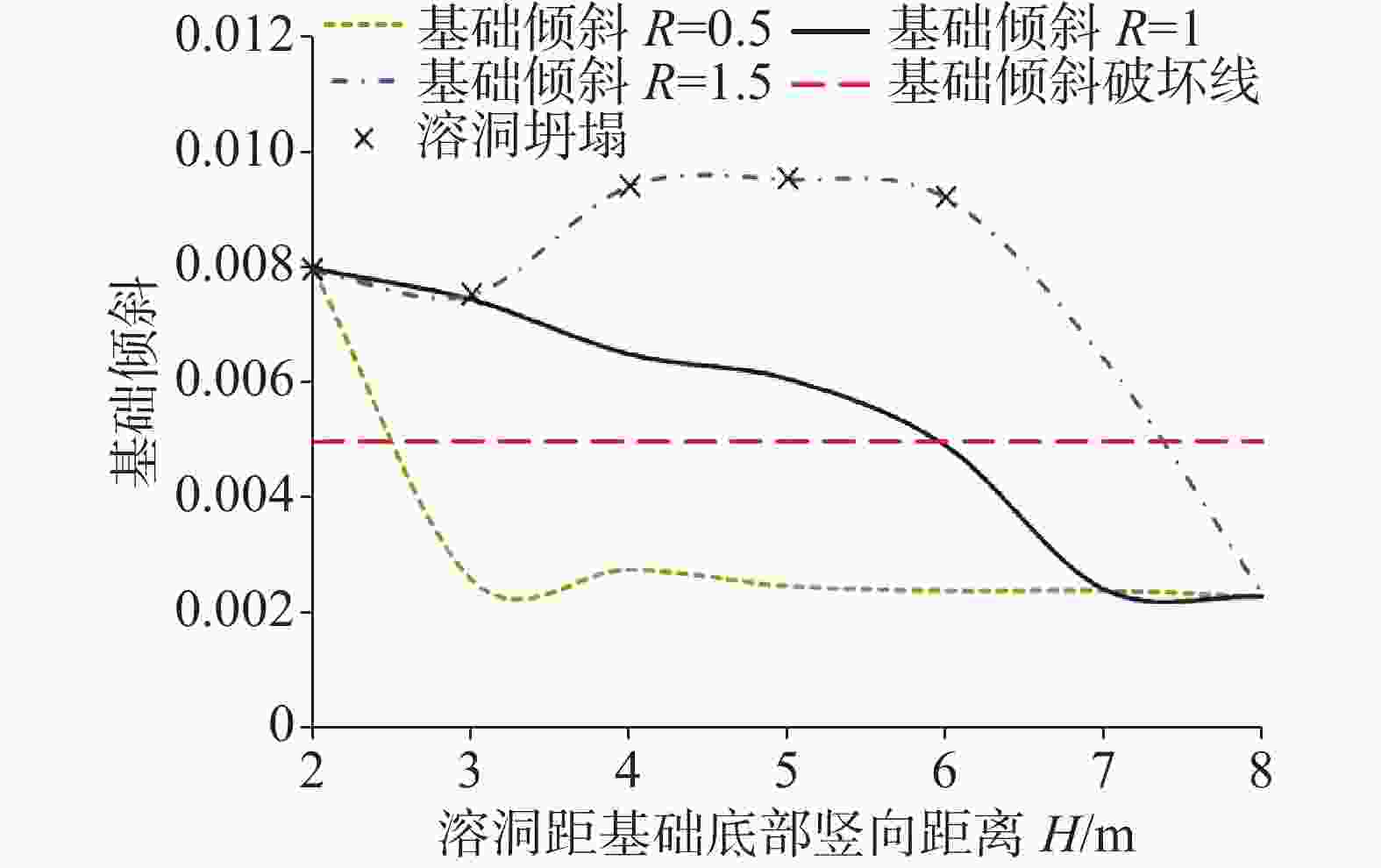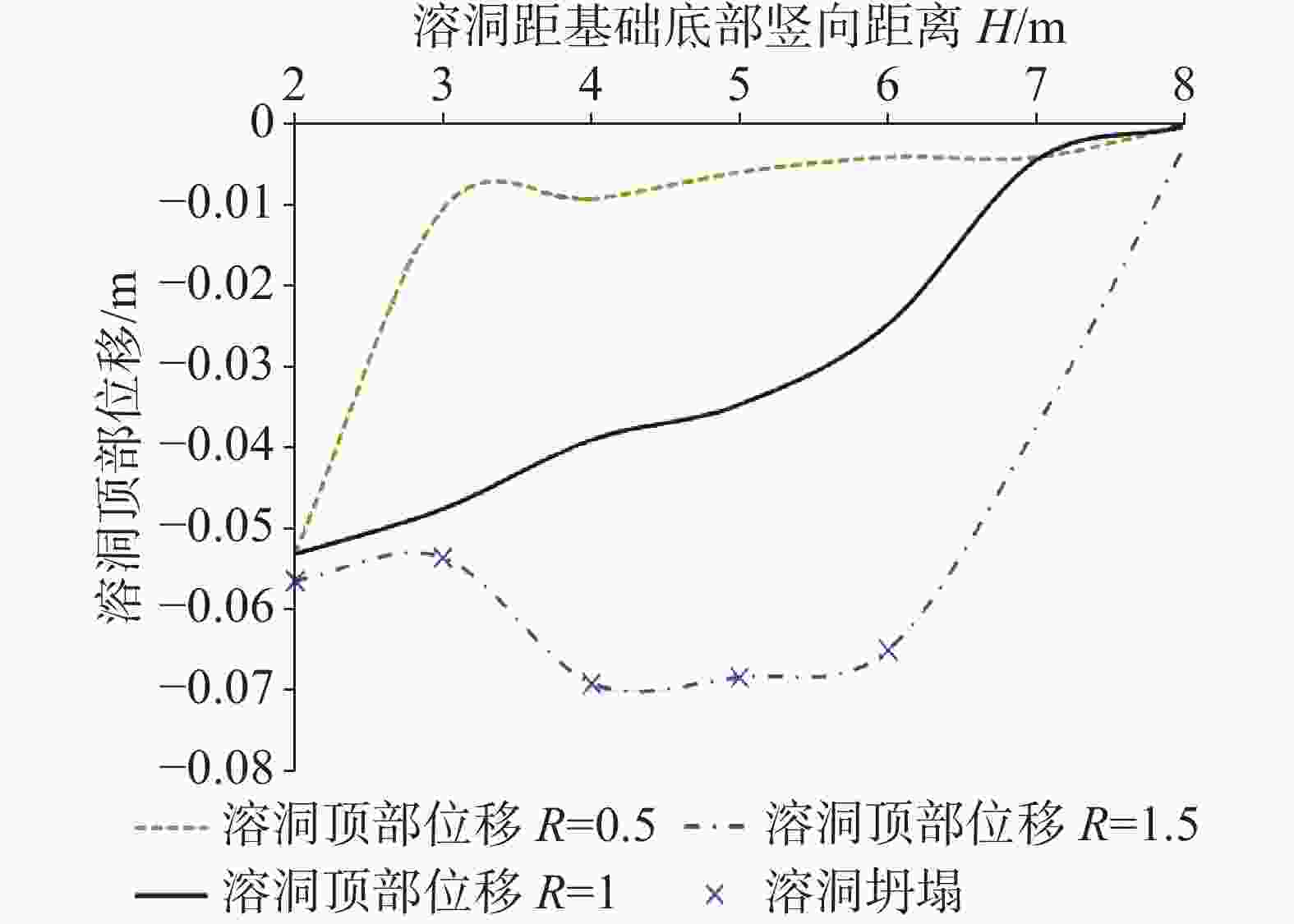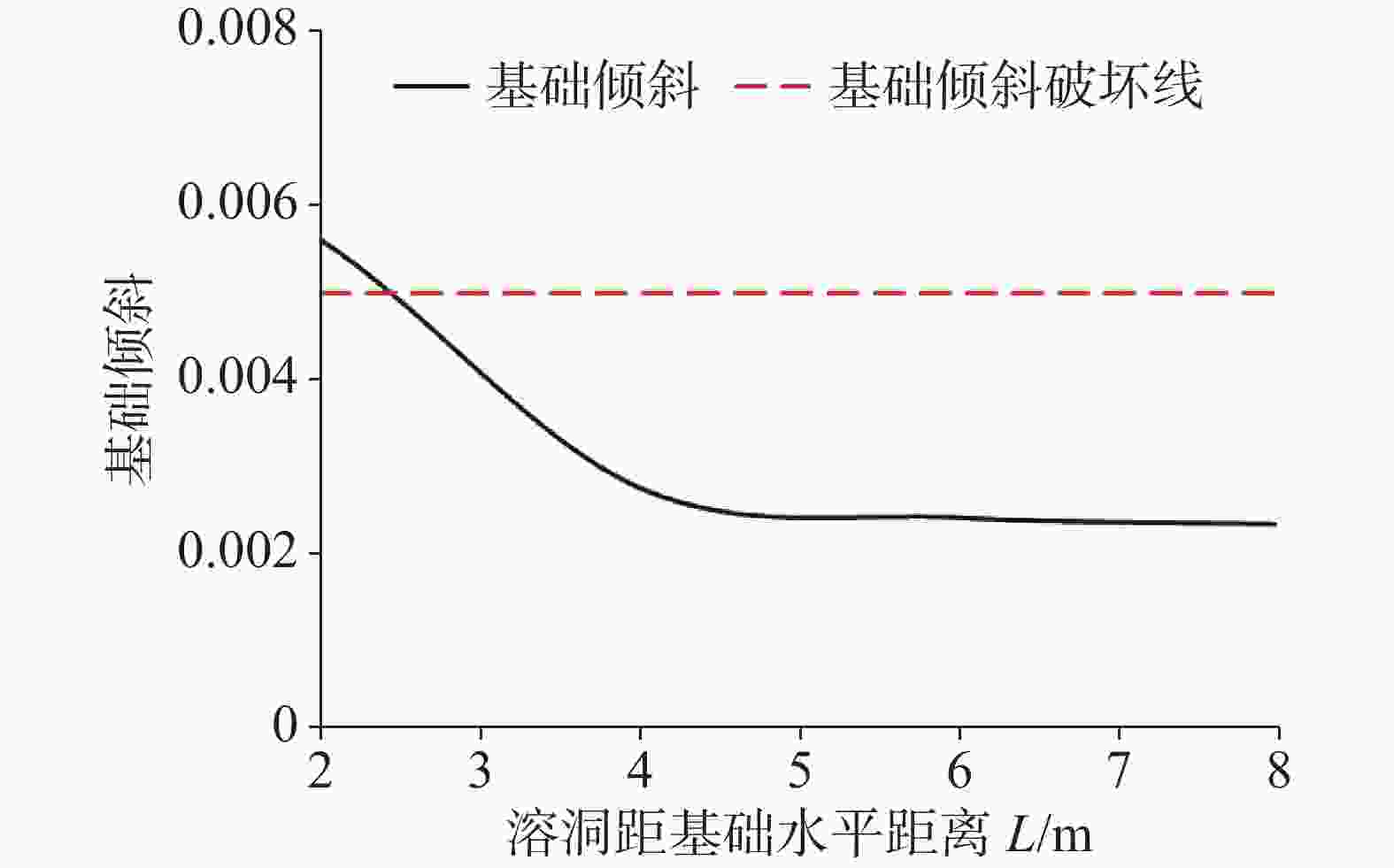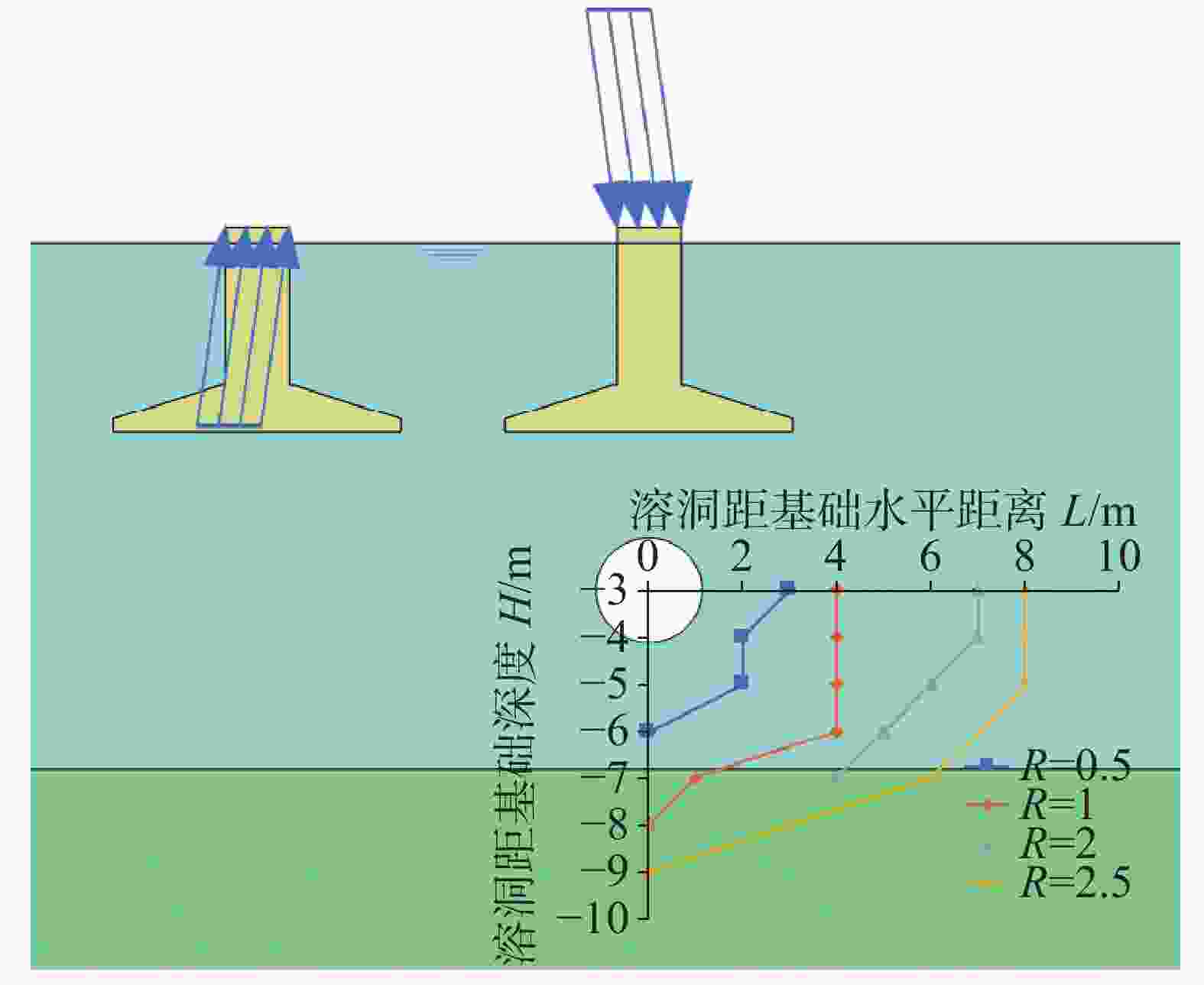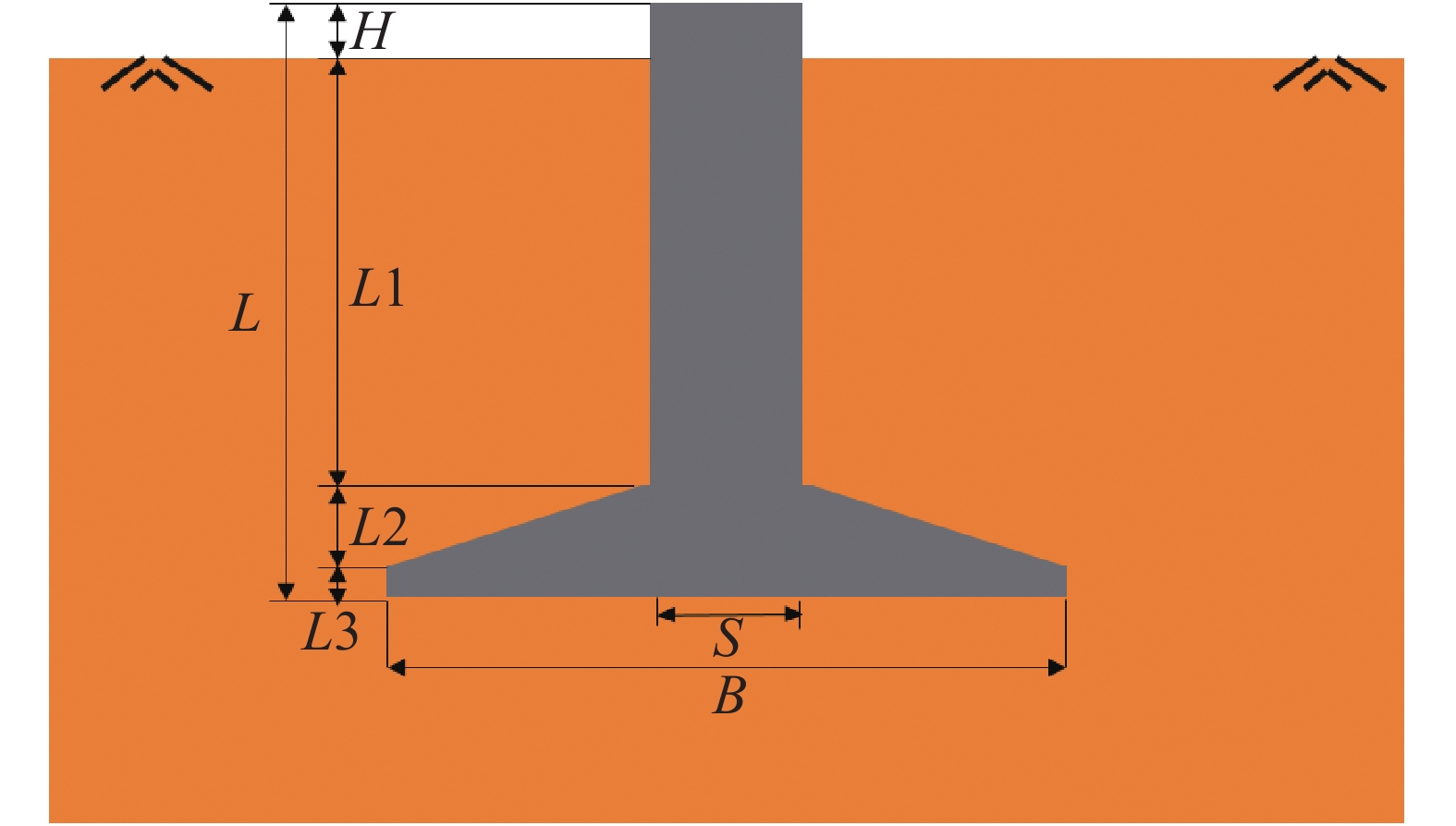Numerical simulation of deformation in the development strata of karst caves for slab foundations and the control of safe distance
-
摘要: 溶洞发育地层对电力铁塔板式基础的安全性存在很大威胁。采用有限元软件,模拟了剪切发展和荷载位移曲线,揭示不同荷载组合、不同溶洞位置和不同溶洞大小下板式基础的变形机理和承载性能。选择最不利工况并结合实际工程,分析溶洞尺寸、溶洞距离板式基础的水平和竖向距离对板式基础变形机制的影响。采用正常使用极限指标地基倾斜限制值为判据,划定了溶洞发育地层板式基础破坏范围,为板式基础在岩溶地层选址提供依据。该方法可为类似岩溶地层电力铁塔板式基础的选址以及溶洞的处置具有一定参考价值。Abstract:
Karst areas are widely distributed throughout China, and karst caves are a common karst form in these regions. As China's economy continues to develop and the demand for rural revitalization intensifies, infrastructure, such as transmission lines, often has to traverse karst areas. In the entire process of infrastructure construction, ensuring the safety of foundations in karst strata is of utmost importance. The existence of karst caves significantly increases the complexity of the deformation of slab foundations. Unfortunately, the failure modes and deformation mechanisms of these foundations in such environments remain unclear. This lack of understanding makes it extremely difficult to propose targeted prevention and control measures in engineering practice. To address this issue, finite element software PLAXIS 2D is employed to establish a numerical model of the slab foundation of electric power towers in karst strata. This model is used to simulate the development of shear bands and load-displacement curves, thereby elucidating the failure mechanisms and conducting analysis on bearing characteristics of slab foundations in karst strata. Against the backdrop of real-world projects, finite element software is utilized to determine the most adverse simulation working conditions. Key factors including relative locations, sizes, and burial depths of karst caves, have been studied to determine their influence on the deformation of transmission tower foundations. Through this research, the deformation mechanism and bearing performance of slab foundations under various load combinations, different locations of karst cave, and varying sizes of karst caves have been examined. Based on the criterion—the limit value of foundation inclination in the serviceability limit state—the failure range of slab foundations in karst strata was delineated. This delineation may provide a crucial basis for the site selection of slab foundations in karst strata. The study results show that the locations, sizes, and load types of karst caves significantly influence the development of shear bands and the failure mechanisms of foundation soil. Affected by the locations of karst caves and the varying tension and compression loads on both sides, slab foundations exhibit diverse failure modes and bearing characteristics. Whether it involves a compression-compression combination or a tension-compression combination, the shear strain will pass from the compressed side of the foundation close to the karst cave into the karst cave. This may result in the formation of an arc-shaped shear band between the karst cave and the foundation. The most unfavorable situation occurs when a karst cave is developed directly beneath a compressed foundation. In terms of the bearing capacity of the foundation in karst strata, this capacity increases as the ratio of diameter (D) to width (B) decreases. Therefore, in practical engineering, the width of the slab should be maximized relative to the diameter of the karst cave. When the ratio D/B exceeds 1, further increase of the width of the slab foundation does not significantly enhance the bearing capacity of the foundation. Additionally, the larger the radius of the karst cave and the closer it is to the foundation, the more pronounced the impact on the inclination of the transmission tower. However, it is important to note that the influence of karst caves on transmission towers is limited to a specific range. Based on the numerical results, a safety design diagram of transmission tower foundations in karst strata is proposed, delineating the safety area of slab foundations. This design diagram aids to determine the construction locations of transmission towers, which can help reduce both line costs and expenses related to karst cave treatment, providing valuable reference for line site selection. This method can provide significant guidance for the site selection of slab foundations of electric power towers in similar karst strata and the management of karst caves. For the site selection of slab foundations for electric power towers, engineers can utilize the analysis results generated by this method to comprehensively consider various factors and select the most appropriate construction location. This approach can effectively minimize the risk of foundation deformation and enhance the stability and safety of electric power towers. At the same time, this method also helps to plan and design foundation structures in advance, allowing for better adaptation to the special geological conditions of karst strata. This approach also minimize uncertainties and difficulties during subsequent construction phrases. In terms of the management of karst caves, this method provides a basis for formulating scientific and reasonable treatment plans. According to the influence of karst caves on the inclination of transmission towers and the relationship between foundation bearing capacity and parameters related to karst caves, targeted measures such as filling and reinforcement can be implemented. In addition, by delineating the failure range of slab foundations in karst strata, the areas requiring focused attention and treatment can be identified more clearly, thereby enhancing the efficiency and effectiveness of karst cave treatment. -
Key words:
- karst cave /
- foundation /
- incline /
- numerical simulation /
- failure mechanism
-
表 1 岩溶地层板式基础材料参数
Table 1. Material parameters of slab foundations in karst strata
材料 容重
/kN·m−3黏聚力
/kPa内摩擦角
/°压缩模量
/MPa泊松比 石灰岩 22 1500 40 1300 0.35 混凝土 25 \ \ 30000 0.2 -
[1] 张乾青, 乔胜石, 邢宇铖, 张凯, 崔伟, 王志远, 陈迪杨. 穿越无充填溶洞时单桩承载特性研究[J]. 湖南大学学报(自然科学版), 2022, 49(7):186-196.ZHANG Qianqing, QIAO Shengshi, XING Yucheng, ZHANG Kai, CUI Wei, WANG Zhiyuan, CHEN Diyang. Study on bearing characteristics of single pile crossing unfilled karst cave[J]. Journal of Hunan University (Natural Sciences), 2022, 49(7): 186-196. [2] 陈慧芸, 冯忠居, 蔡杰, 夏承明, 董建松. 串珠状溶洞影响下桩基竖向承载特性离心试验[J]. 哈尔滨工业大学学报, 2023, 55(6):83-93.CHEN Huiyun, FENG Zhongju, CAI Jie, XIA Chengming, DONG Jiansong. Centrifugal test on vertical bearing characteristics of pile foundation affected by beaded caverns[J]. Journal of Harbin Institute of Technology, 2023, 55(6): 83-93. [3] 周雷靖, 余国兆, 林伟斌. 电厂溶洞地基处理关键技术和疑难问题分析[J]. 南方能源建设, 2022, 9(Suppl.1):69-75.ZHOU Leijing, YU Guozhao, LIN Weibin. Key technology and difficult problem analysis of karst cave treatment in power plant project[J]. Southern Energy Construction, 2022, 9(Suppl.1): 69-75. [4] 赵少忠, 黄鑫, 许振浩, 李明海. 齐岳山隧道岩溶发育特征与溶洞处治技术研究[J]. 隧道建设(中英文), 2022, 42(7):1289-1299.ZHAO Shaozhong, HUANG Xin, XU Zhenhao, LI Minghai. Development characteristics and treatment techniques of karst caves in Qiyueshan tunnel[J]. Tunnel Construction, 2022, 42(7): 1289-1299. [5] 雷勇, 李鹏甲, 刘泽宇, 李金朝, 胡伟, 陈俐光, 刘运思. 岩溶区穿越溶洞桩基极限承载力及破坏模式试验研究[J]. 应用力学学报, 2023, 40(6):1343-1353.LEI Yong, LI Pengjia, LIU Zeyu, LI Jinzhao, HU Wei, CHEN Liguang, LIU Yunsi. Experimental study on ultimate bearing capacity and failure mode of pile foundation crossing karst caves in karst areas[J]. Chinese Journal of Applied Mechanics, 2023, 40(6): 1343-1353. [6] Zheng Jinbei, Zhang Hu, Liu Baoqiang, Liu Gao, Fan Youping, Hua Shuai, Jiang Daixing. Research on pile foundation of transmission tower stability analysis based on numerical simulation in karst areas[J]. Advanced Materials Research, 2012, 594-597: 316-319. [7] 许新刚, 刘厚健. 地质雷达在高电压等级输电线路勘察中的应用[J]. 电力勘测设计, 2008(4):18-21. doi: 10.3969/j.issn.1671-9913.2008.04.005XU Xingang, LIU Houjian. Application of ground penetrating radar in high voltage transmission line's geologic investigation[J]. Electric Power Survey and Design, 2008(4): 18-21. doi: 10.3969/j.issn.1671-9913.2008.04.005 [8] 刘小东, 彭斌, 黄河, 柳建新. 地质雷达在溪洛渡—浙西±800kV特高压直流输电线路工程塔基勘察中的应用[J]. 工程地质学报, 2013, 21(5):722-729. doi: 10.3969/j.issn.1004-9665.2013.05.008LIU Xiaodong, PENG Bin, HUANG He, LIU Jianxin. Application of ground penetrating radar to tower pad investigation of ±800 kV DC power transimission project from Xiluodu to Zhexi[J]. Journal of Engineering Geology, 2013, 21(5): 722-729. doi: 10.3969/j.issn.1004-9665.2013.05.008 [9] 许腾晖, 门春树. 对某工程岩溶发育特征及基础选型分析[J]. 城市勘测, 2022(3):206-208.XU Tenghui, MEN Chunshu. Analysis on karst development characteristics and foundation selection of a project[J]. Urban Geotechnical Investigation & Surveying, 2022(3): 206-208. [10] 郑金杯, 刘高, 沈虹, 樊友平, 滑帅, 蒋代兴. 广东岩溶塌陷区输电线路塔基稳定性评估方法及数值模拟研究[J]. 电力建设, 2012, 33(12):44-47.ZHENG Jinbei, LIU Gao, SHEN Hong, FAN Youping, HUA Shuai, JIANG Daixing. Stability evaluation methods and numerical simulation study of transmission tower foundation in Guangdong karst collapse areas[J]. Electric Power Construction, 2012, 33(12): 44-47. [11] 江兆云, 曾德森. 输电线路岩溶地区勘探方法及地基稳定性分析[J]. 资源环境与工程, 2010, 24(2):162-165.JIANG Zhaoyun, ZENG Desen. Foundation bed stability analysis and exploration methods of transmission line in karst area[J]. Resources Environment and Engineering, 2010, 24(2): 162-165. [12] 刘泽坤. 复杂岩溶地质条件下厂房地基基础设计[J]. 煤炭工程, 2022, 54(4):22-26.LIU Zekun. Design of powerhouse foundation under complex karst geological conditions[J]. Coal Engineering, 2022, 54(4): 22-26. [13] 柳柳, 王俊. 广花盆地东北部岩溶地质特征及对城际铁路隧道影响分析[J]. 铁道勘察, 2022, 48(4):72-78.LIU Liu, WANG Jun. Characteristics of karst in the northeast Guanghua basin and analysis of its influence on intercity railway tunnels[J]. Railway Investigation and Surveying, 2022, 48(4): 72-78. [14] 肖雄, 毛土明. 湖南省岩溶地质条件下高层建筑基础设计研究与实践[J]. 建筑结构, 2022, 52(Suppl.1):2321-2324.XIAO Xiong, MAO Tuming. Research and practice on foundation design of high-rise buildings under karst geological conditions in Hunan Province[J]. Building Structure, 2022, 52(Suppl.1): 2321-2324. [15] 黎志豪, 许光泉, 余世滔, 高加林, 张海涛. 淮南舜耕山岩溶塌陷发育特征及形成机理研究[J]. 中国岩溶, 2019, 38(3):418-426.LI Zhihao, XU Guangquan, YU Shitao, GAO Jialin, ZHANG Haitao. Study on the development characteristics and formation mechanism of karst collapse development in Shungeng mountain, Huainan City[J]. Carsologica Sinica, 2019, 38(3): 418-426. [16] 谢小荣, 苏定立, 李翔, 胡贺松. 基于综合勘察分析的工程建设场地岩溶发育机理及场地稳定性研究[J]. 广州建筑, 2021, 49(6):3-7.XIE Xiaorong, SU Dingli, LI Xiang, HU Hesong. Karst development mechanism and site stability of engineering construction site based on comprehensive investigation analysis[J]. Guangzhou Architecture, 2021, 49(6): 3-7. [17] 尹欧, 杨帆, 彭祖武, 向锋. 长沙市煤炭坝地区岩溶发育机理及空间分布规律研究[J]. 资源环境与工程, 2021, 35(2):216-220.YIN Ou, YANG Fan, PENG Zuwu, XIANG Feng. Study on karst development mechanism and spatial distribution law in Meitanba area of Changsha[J]. Resources Environment and Engineering, 2021, 35(2): 216-220. [18] 左文喆, 董军义, 刘善军, 张淑娟, 费书民. 唐山市北部山区岩溶塌陷机制初探[J]. 工程勘察, 2008(8):29-32.ZUO Wenzhe, DONG Junyi, LIU Shanjun, ZHANG Shujuan, FEI Shumin. Mechanism of karst collapse in the hilly area of northwestern Tangshan[J]. Geotechnical Investigation & Surveying, 2008(8): 29-32. [19] 魏风华. 唐山市岩溶塌陷机制分析[J]. 地质与勘探, 2006, 42(2):86-89.WEI Fenghua. Study in the mechanism of karst collapse in Tangshan City[J]. Geology and Prospecting, 2006, 42(2): 86-89. [20] 张永兵, 唐滢, 梁星云, 陈挚. 土弹性模量对土—结构共同作用体系影响分析[J]. 广西大学学报(自然科学版), 2016, 41(4):1139-1144.ZHANG Yongbing, TANG Ying, LIANG Xingyun, CHEN Zhi. Impact of soil elastic modulus on soil-structure interaction[J]. Journal of Guangxi University (Natural Science Edition), 2016, 41(4): 1139-1144. [21] 岳鹏飞, 蒋大园. 岩溶地区高层建筑桩基设计探讨[J]. 工程建设, 2020, 52(12):53-56.YUE Pengfei, JIANG Dayuan. Discussion on pile foundation design of high-rise buildings in karst area[J]. Engineering Construction, 2020, 52(12): 53-56. [22] 何世茂, 鹿磊, 胡艳玲. 岩溶地区基础选型分析和工程应用[J]. 建筑结构, 2022, 52(Suppl.1):2368-2372.HE Shimao, LU Lei, HU Yanling. Analysis and engineering application of foundation selection in karst areas[J]. Building Structure, 2022, 52(Suppl.1): 2368-2372. [23] 张建同, 陈顺军, 刘素梅, 林鲁生, 徐礼华. 隐伏岩溶条件下的上部结构-基础-地基共同作用数值模拟分析[J]. 中国岩溶, 2018, 37(5):792-798. doi: 10.11932/karst20180518ZHANG Jiantong, CHEN Shunjun, LIU Sumei, LIN Lusheng, XU Lihua. Numerical simulation analysis of interaction of superstructure-foundation-pile foundation under hidden karst condition[J]. Carsologica Sinica, 2018, 37(5): 792-798. doi: 10.11932/karst20180518 [24] 刘自强, 马洪生, 牟云娟. 节理裂隙发育岩溶地基数值模拟稳定性分析[J]. 中国岩溶, 2022, 41(1):100-110. doi: 10.11932/karst20220105LIU Ziqiang, MA Hongsheng, MOU Yunjuan. Numerical simulation analysis and evaluation of stability of the karst foundation with developed joints and fissures[J]. Carsologica Sinica, 2022, 41(1): 100-110. doi: 10.11932/karst20220105 [25] 邓艺聪. 岩溶地区高层建筑桩筏基础溶洞安全性评价方法研究[D]. 广州:华南理工大学, 2017.DENG Yicong. Research on safety evaluation method of piled-raft foundation of tall buildings in karst region[D]. Guangzhou: South China University of Technology, 2017. [26] 曾勇, 单海东, 贺燚, 龚雷, 秦张越. 桩侧溶洞对桥梁桩基沉降和桩端受力影响分析[J]. 路基工程, 2022(3):146-150.ZENG Yong, SHAN Haidong, HE Yi, GONG Lei, QIN Zhangyue. Influence of karst cave at pile side on settlement of bridge pile foundation and force of pile end[J]. Subgrade Engineering, 2022(3): 146-150. [27] 林湘, 陈相宇, 韦锦呈. 盾构隧道侧穿高压电塔的影响及保护研究[J]. 现代隧道技术, 2022, 59(Suppl.1):426-433.LIN Xiang, CHEN Xiangyu, WEI Jincheng. Research on the influence and protection of shield tunnel through high voltage tower[J]. Modern Tunneling Technology, 2022, 59(Suppl.1): 426-433. [28] 翁佳明, 邓志健. 某110 kV电塔基础加固及纠偏工程施工方法[J]. 广东土木与建筑, 2021, 28(4):77-80.WENG Jiaming, DENG Zhijian. Construction method for foundation reinforcement and deviation rectification of a 110 kV power tower [J]. Guangdong Architecture & Civil Engineering, 2021, 28(4): 77-80. [29] 谢瑾荣. 下穿隧道盾构施工对高压电塔影响的安全性评价[J]. 土工基础, 2020, 34(2):89-93.XIE Jinrong. Safety evaluation of the impact of shielded tunneling construction on an electricity tower foundation[J]. Soil Engineering and Foundation, 2020, 34(2): 89-93. [30] 彭学军, 吴春勇, 杨杰. 桥梁桩基施工对其邻近电塔基础的影响分析[J]. 公路, 2017, 62(7):146-150. [31] 秦忠诚, 李晓禾, 门懋进, 高彪. 电塔桩基受采动及风荷载共同影响下的变形特征研究[J]. 矿业安全与环保, 2022, 49(4):181-186.QIN Zhongcheng, LI Xiaohe, MEN Maojin, GAO Biao. Study on deformation characteristics of pile foundation of electric tower under the combined influence of mining and wind load[J]. Mining Safety & Environmental Protection, 2022, 49(4): 181-186. [32] 林权威. 隧道施工对既有高压电塔的影响研究[J]. 地基处理, 2022, 4(1):48-57.LIN Quanwei. Influence of tunnel construction on existing high-voltage power transmission tower[J]. Journal of Ground Improvement, 2022, 4(1): 48-57. -




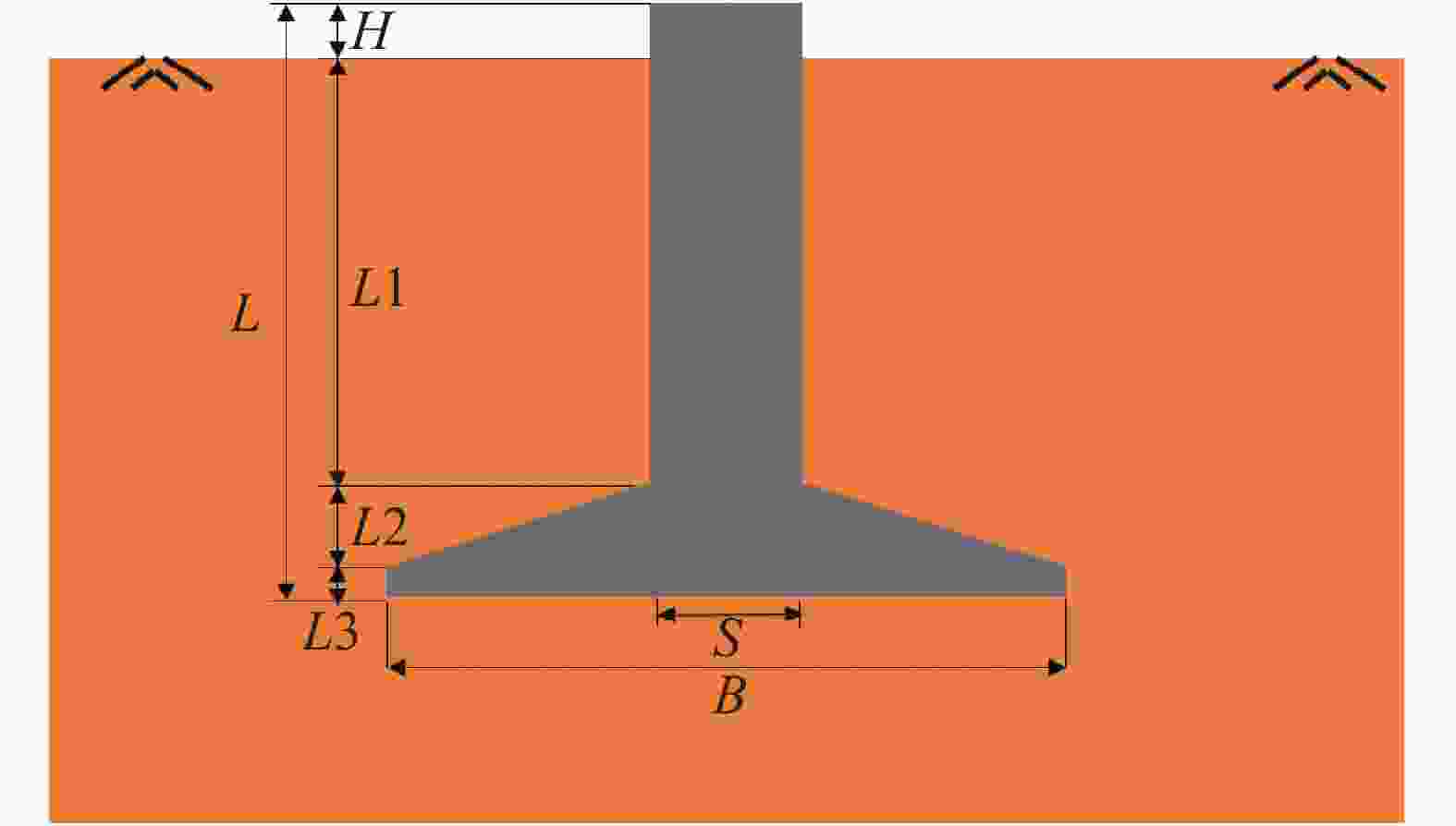
 下载:
下载:
